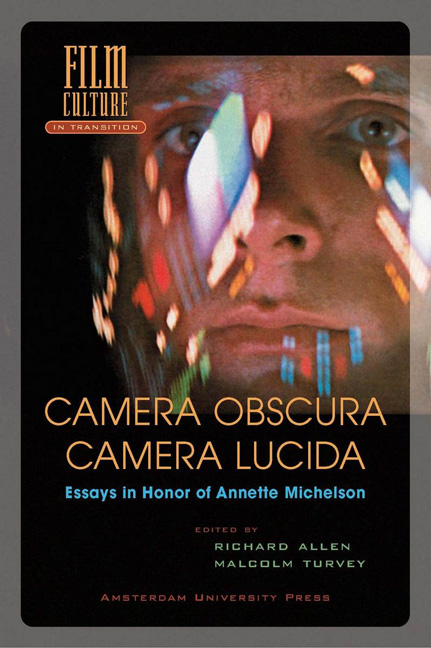Book contents
- Frontmatter
- Contents
- Acknowledgements
- Preface
- Introduction
- The Logic of an Illusion: Notes on the Genealogy of Intellectual Cinema
- Narcissistic Machines and Erotic Prostheses
- Loïe Fuller and the Art of Motion: Body, Light, Electricity and the Origins of Cinema
- Visitings of Awful Promise: The Cinema Seen from Etna
- Transfiguring the Urban Gray: László Moholy-Nagy’s Film Scenario ‘Dynamic of the Metropolis’
- Eisenstein’s Philosophy of Film
- Knight’s Moves
- Hitchcock and Narrative Suspense: Theory and Practice
- From the Air: A Genealogy of Antonioni’s Modernism
- Dr. Strangelove: or: the Apparatus of Nuclear Warfare
- Collection and Recollection: On Film Itineraries and Museum Walks
- Afterward: A Matter of Time: Analog Versus Digital, the Perennial Question of Shifting Technology and Its Implications for an Experimental Filmmaker’s Odyssey
- Select Bibliography
- List of Contributors
- Index
- Film Culture in Transition General Editor: Thomas Elsaesser
The Logic of an Illusion: Notes on the Genealogy of Intellectual Cinema
Published online by Cambridge University Press: 25 January 2021
- Frontmatter
- Contents
- Acknowledgements
- Preface
- Introduction
- The Logic of an Illusion: Notes on the Genealogy of Intellectual Cinema
- Narcissistic Machines and Erotic Prostheses
- Loïe Fuller and the Art of Motion: Body, Light, Electricity and the Origins of Cinema
- Visitings of Awful Promise: The Cinema Seen from Etna
- Transfiguring the Urban Gray: László Moholy-Nagy’s Film Scenario ‘Dynamic of the Metropolis’
- Eisenstein’s Philosophy of Film
- Knight’s Moves
- Hitchcock and Narrative Suspense: Theory and Practice
- From the Air: A Genealogy of Antonioni’s Modernism
- Dr. Strangelove: or: the Apparatus of Nuclear Warfare
- Collection and Recollection: On Film Itineraries and Museum Walks
- Afterward: A Matter of Time: Analog Versus Digital, the Perennial Question of Shifting Technology and Its Implications for an Experimental Filmmaker’s Odyssey
- Select Bibliography
- List of Contributors
- Index
- Film Culture in Transition General Editor: Thomas Elsaesser
Summary
In his influential book Techniques of the Observer, Jonathan Crary traces the intellectual history of vision, visual technologies, and the interest in illusion. He starts with the camera obscura. In his analysis of this device, Crary closely follows Richard Rorty, who in his book Philosophy and the Mirror of Nature, describes the Cartesian intellect as a camera obscura – an empty, dark space in which images are projected onto a screen:
In the Cartesian model, the intellect inspects entities modeled on retinal images … In Descartes’ conception – the one which became the basis for modern epistemology – it is representations which are in the ‘mind.’ The inner Eye surveys these representations hoping to find some mark which will testify to their fidelity.
Crary in his own way repeats this important claim:
In the Second Meditation, Descartes asserts that ‘perception, or the action by which we perceive, is not a vision … but solely an inspection by the mind’… For Descartes, one knows the world ‘uniquely by perception of the mind,’ and the secure positioning of the self within an empty interior space is a precondition for knowing the outer world. The space of the camera obscura, its enclosedeness, its darkness, its separation from the exterior, incarnates Descartes’, ‘I will now shut my eyes, I shall stop my ears, I shall disregard my senses.’
According to Crary, the camera obscura is an epistemological model because it transforms the randomness of sensory data into a rational, intellectual vision whose apparatus ‘corresponds to a single, mathematically definable point, from which the world can be logically deduced by a progressive accumulation and combination of signs. It is a device embodying man's position between God and the world.’
The assertion that the camera obscura, an instrument of illusion, was used in Descartes’ times as a model for rational understanding is, in my opinion, questionable. 4 But even more questionable is the way Crary uses it to describe the evolution of the conceptualization of vision inWestern culture. In his view, the camera obscura gradually loses its dominance as a model, and the objective rationality it guaranteed is progressively replaced by a conception of vision as subjective along with an acute interest in illusion, in particular in optical illusion. This shift from rational, objective epistemology to subjective vision and illusion, according to Crary, opens the way to all the innumerable nineteenth century optical toys, and eventually cinema.
- Type
- Chapter
- Information
- Camera Obscura, Camera LucidaEssays in Honor of Annette Michelson, pp. 35 - 50Publisher: Amsterdam University PressPrint publication year: 2003



